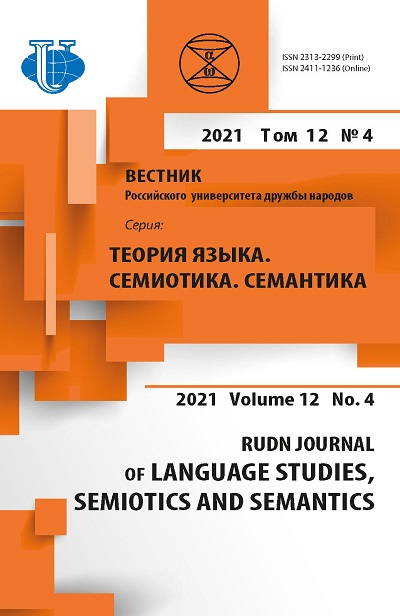Gender Stereotypes in Teaching Aids on Russian as a Foreign Language for Beginners
- Authors: Artyukhova N.S.1, Saykina O.S.1, Solovyeva A.A.1
-
Affiliations:
- Russian State Agrarian University - Moscow Agricultural Academy named after K.A. Timiryazev (RSAU-MTTA)
- Issue: Vol 12, No 4 (2021)
- Pages: 1236-1246
- Section: RUSSIAN LANGUAGE AND INTERCULTURAL COMMUNICATION
- URL: https://journals.rudn.ru/semiotics-semantics/article/view/29889
- DOI: https://doi.org/10.22363/2313-2299-2021-12-4-1236-1246
Cite item
Full Text
Abstract
The paper brings up the issue of reflecting gender roles in textbooks for international students, investigates which concepts of men and women they can potentially form among foreign students on the basis of these teaching aids. The aim of the present study is to describe the gender roles of men and women in the textbooks of the Russian language for beginners. For that, it was necessary to solve a number of tasks, such as fixing examples of gender-characterized units in teaching aids; creating a system of categories for comparison and comparing the analysis results of all involved textbooks. The following methods of qualitative content analysis, classification method, comparison method were used in the work. Popular textbooks on Russian as a foreign language were taken for the analysis. This study makes it possible to investigate gender roles in Russian culture through the spectacle of the textbooks for foreigners, allowing us to get a new angle on the correlation of gender characteristics. The study can also be used by future textbook authors to further develop textbook characters in terms of their gender roles. The authors of the study conclude that textbook representations convey stereotypic ideas about the roles of men and women, but these images cannot be recognized as corresponding to extra-linguistic reality, which can potentially result in communication failures among foreign students when interacting with Russians.
About the authors
Natalya S. Artyukhova
Russian State Agrarian University - Moscow Agricultural Academy named after K.A. Timiryazev (RSAU-MTTA)
Author for correspondence.
Email: artiuhova@rgau-msha.ru
ORCID iD: 0000-0003-0949-1902
Assistant professor of Department of Russian as a Foreign Language and General Theoretical Subjects of Institute of Economics and Management of Agroindustrial Complex
49, Timiryazevskaya str, Moscow, Russian Federation, 127550Olga S. Saykina
Russian State Agrarian University - Moscow Agricultural Academy named after K.A. Timiryazev (RSAU-MTTA)
Email: saikina-olga@yandex.ru
ORCID iD: 0000-0001-7886-6769
Assistant professor of Department of Russian as a Foreign Language and General Theoretical Subjects of Institute of Economics and Management of Agroindustrial Complex
49, Timiryazevskaya str, Moscow, Russian Federation, 127550Anna A. Solovyeva
Russian State Agrarian University - Moscow Agricultural Academy named after K.A. Timiryazev (RSAU-MTTA)
Email: yarlee@yandex.ru
ORCID iD: 0000-0001-9472-5966
Assistant professor of Department of Russian as a Foreign Language and General Theoretical Subjects of Institute of Economics and Management of Agroindustrial Complex
49, Timiryazevskaya str, Moscow, Russian Federation, 127550References
- Dezhina, T.P. (2017). Stages of the formation of the concept of “gender” in foreign and domestic linguistics. Philology. Theory & Practice, 4(70)—1, 76—79. (In Russ.).
- Wodak, R. & Benke, G. (2017). Gender as a Sociolinguistic Variable: New Perspectives on Variation Studies. The Handbook of Sociolinguistics, 8, 127—150. DOI: 10.1002/ 9781405166256.ch8
- Belova, N.V. (2009). Gender stereotypes of linguistic consciousness. Rhema. Rema, 1. URL: https://cyberleninka.ru/article/n/gendernye-stereotipy-yazykovogo-soznaniya (accessed: 05.03.2021). (In Russ.).
- Kim, L. (2007). Gender stereotypes. Introduction to the theory and practice of gender relations: Inter-university collection of scientific tr. Tashkent. pp. 44—61. (In Russ.).
- Poryadina, Yu.V. & Chernetsova, V.D. (2020). Examples of sexism in Russian language textbooks for foreigners. Translation. Language. Culture. St. Petersburg, May 29—30, 2020. St. Petersburg: LGUI named after A.S. Pushkin. pp. 363—367. (In Russ.).
- Kirpikov, A.R. (2018). Qualitative content analysis as a research method. Culture, personality, society in the modern world: methodology, empirical research experience, 21, 67—74. (In Russ.).
- Ermachenkova, V.S. (2015). The word: a manual on vocabulary and conversational practice. St. Petersburg: Zlatoust.
- Antonova, V.E., Nahabina, MM., Safronova, M.V. & Tolstyih, A.A. (2012). The Road to Russia: textbook of the Russian language (elementary level). St. Petersburg: Zlatoust. (In Russ.).
- Konshina, S.G. & Marina, E.S. (2018). Dialogue. Russian for beginners. Practical course (elementary level). Moscow: KREF. (In Russ.).













